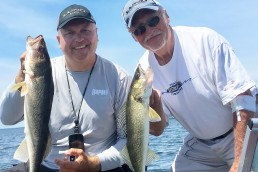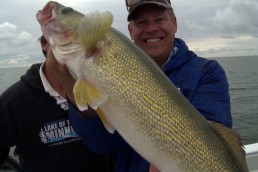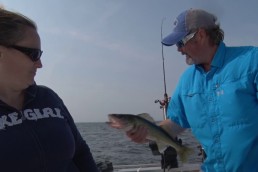Lake Basin Walleyes
SHARE THIS POST
Precise speed and depth control lead to trolling success
“There’s one,” I called out as I looked at the screen of my Humminbird Helix 12. “Charted two more,” I said a few seconds later as two more nice marks showed up on the screen, a couple feet off of bottom. “We’ve gotta get one of them,” my dad said as he peeked at the screen as well. A few seconds later, one of the rods in the holder snapped over, and the clicker on the line counter reel signaled that the drag was slipping out. Dad grabbed the rod out of the holder. I slowed the Mercury 9.9 Pro Kicker to a crawl when he indicated it was not a large fish. A minute later, I was netting a 20-inch walleye. Dad popped the #5 Shad Rap out of the fish, slid the fish over the side of the boat, and I revved the kicker back up as he began to feed out line with the Shad Rap behind the boat.
We were on central Minnesota’s Mille Lacs Lake and were obviously trolling crankbaits for walleyes. It was midsummer, and the fish were deep. They were feeding on small forage common in a large natural lake this time of year after countless baitfish and insect hatches. We needed to get small crankbaits, designed to run three to five feet deep, 28 to 32 feet down.
How did we pull this off? Simple—we were using leadcore line to get the small baits down deep, and we were trolling quickly to cover water and trigger reaction strikes from well-fed summertime walleyes. While this is a technique that many people haven’t tried before, it is a simple and effective way to catch summertime walleyes in many bodies of water.
That day on Mille Lacs, we were targeting walleyes not located on any “classic” walleye structure. We were on the north half of Mille Lacs’ famous for “mud flats.” Many of these fertile, soft, “muck” plateaus rise up five to ten feet above the 30- to 35-foot-deep lake basin of Mille Lacs. They range in size from a football field to a couple miles long, and they hold food and walleyes most of the year. As you can imagine, they get extreme fishing pressure, especially through the ice in winter and during the warm summer months.
Leeches and nightcrawlers presented below slip floats, on live bait rigs, and behind spinners are used by countless anglers each year at the top and bottom edges of these mud flats. When the fishing pressure gets too heavy, many of these fish will move over the lake basin, out away from these fishing hot spots. Some of the biggest walleyes in the lake spend the summer months in 30 to 35 feet of water, feeding on bloodworms and insect larvae coming from the soft bottom, and on small perch and minnows feeding on the same small forage themselves.
These walleyes are targeting small forage, so we needed to “match the hatch” in the clear-water conditions. This had us trolling #5 Shad Raps and Jointed Shad Raps, as well as the Ultra-light Shad. To get these shallow running baits down to the fish, within six feet of the bottom in 30-plus feet of water, we had our linecounter reels spooled with Suffix 832 Advanced Leadcore line. We then spliced 20 feet of Berkley Vanish fluorocarbon line to the leadcore as leaders and attached the crankbaits with crankbait snaps.
In order to get the baits where we were seeing fish on our electronics, we used the following speed and line formulas to achieve and duplicate the right depth. With the 12-pound-test leadcore line we were using, the line was divided into ten different colors, with each color being ten yards of line. At a trolling speed of two miles per hour, we got about seven feet of depth for our baits for every color of internally weighted leadcore line in the water. Since we were targeting fish that we were seeing two to five feet off of bottom in 30 to 34 feet of water, we wanted our baits running 26 to 28 feet down. This would keep them running at or just above the walleyes we were seeing on the Humminbird. This meant that we were running four colors of leadcore, give or take a few feet, in the water.
Are you enjoying this post?
You can be among the first to get the latest info on where to go, what to use and how to use it!
The shallow diving action of the #5 Shad Raps didn’t add more than a few inches of depth to the offerings at that speed. The 10-pound-test fluorocarbon leader was for stealth in water in which we could see nearly ten feet down in. That same leadcore line, when trolled at a speed of three miles per hour, will give you about four feet of depth for every color out. So, the faster you troll, the more leadcore you need to have out to achieve the same depth, and the slower you go the less leadcore you need out. For speeds in between two and three miles per hour, and depths between multiples of seven or four, you will need to do a little math to get the right amount of line out with the speed you are traveling to get the bait to the depth you want. A linecounter reel can help with putting out a portion of a color of leadcore; each color of Suffix 832 Advanced Leadcore is ten yards or thirty feet.
To dial in the correct combination of trolling speed and length of leadcore line out, you need the right equipment and need to be good at using it. I like to use the 9.9 Mercury Pro Kicker on my 1875 Pro V to troll crankbaits with leadcore. The gas kicker engine on the stern of my boat is set up for tiller steering. I have better steering response with a tiller handle than with the kicker hooked up to the steering wheel, and with speed and steering all in one hand, the tiller kicker keeps a hand open if I want to hold a rod while trolling or backtrolling. With the I-Link features of my Humminbird linked to my 112-pound-thrust MinnKota Ulterra, I can also use this to troll in calm conditions, trolling at two mph for hours without draining the batteries.
As mentioned before, I like to use a large linecounter reel to hold ten colors of leadcore, and still give you the foot measurements to dial in the right amount of line out. Abu Garcia makes a couple models, one analog and one digital, of great linecounter reels. I like to use 7-foot, medium-heavy power, moderate-fast-action rods in the rear rod holders to run as inside lines. If more than two lines are needed and allowed, I use the same power and action rods that telescope out to 8 or 8 feet in length to put in more forward rod holders, to run as outside lines. St. Croix and Clam (Jason Mitchell) make some great trolling rods.
Finally, you need to choose your crankbaits. Some days color will matter, and some days it won’t. Have some natural colors like silver, gold, crawfish and perch, as well as some brighter colors like firetiger, chartreuse or orange. In the warm water of summertime, I like the action of a Shad Rap or Jointed Shad Rap. Let the fish tell you the size of bait, but #4 or #5 is a good place to start, and sometimes even going down to the Ultralight Shad will be the way to go. Baitfish and insect hatches take place in the summer, so walleyes are often dialed in on smaller forage; that is why I recommend the smaller-sized crankbaits.
Keep the hooks sharp, and experiment with color. You can hold onto the rods or put them in rod holders. But if you hold onto the rod, don’t try an aggressive hook set when you feel a strike. Just hold on and allow the moderate-action rod to slowly load up, which allows the fish to get the fast-moving bait into its mouth. Then simply play the fish back to the boat. Take your time and don’t try to hurry a fish in, as the leadcore and fluorocarbon lines don’t stretch and too much pressure can tear the hooks out of the fish.
That summer day on Mille Lacs, my dad and I caught a bunch of walleyes of all sizes, plus a few jumbo perch on our small crankbaits trolled deep using leadcore line. This deep-water pattern plays out in lakes all across the Midwest in the summertime, and trolling crankbaits with leadcore line is a great technique to target these fish. Don’t be shy to try something new. This technique is simple, effective and has become my favorite way to target deep summertime walleyes. I bet it will become yours, too, if you give it a try.
MWO
SHARE THIS POST
Did you enjoy this post?
You can be among the first to get the latest info on where to go, what to use and how to use it!
Troy Smutka
Troy Smutka is a central Minnesota fishing guide (greatdayonthewater.com) and a walleye tournament angler. He is also a member of the Lund Boats, Mercury Outboards and Johnson Outdoors Pro Teams, and hosts and produces Fishing and Hunting the North Country on YouTube.



